8.3. Users¶
Administration → Users
In the Users menu of the administration site administrators can:
- search for users
- change settings for individual users
- suspend and delete users
- make users site staff or administrators
- check the administrator notification settings
- add and update users manually or by CSV
- view reports
In the Users menu of the administration institution administrators can:
- search for users
- change settings for individual users
- suspend and delete users
- check the administrator notification settings for their institution’s administrators
- add and update users manually or by CSV
- view reports
8.3.1. User search¶
Administration → Users → User search
Notitie
Site administrators can search for any user on the entire site while institution administrators can only search among the users of their institution(s).
You can search for their
- first name
- last name
- display name
- username
- email address
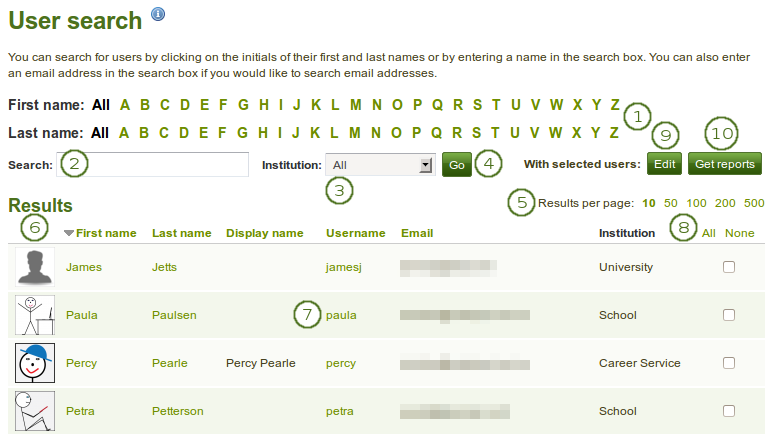
User search
You can combine any search and filter options. However, if you use too many, you may not yield any results.
- Filter the users you wish to display by their initials of the first and / or last name.
- Search: Type the name, display name, username or email address or any partial thereof you wish to search for in the search field. If you turned on the exact search, you need to provide the correct name or email address and not a partial one.
- Institution: Choose the institution from the drop-down menu in which you wish to search for the user.
- Click the Go button to start searching.
- Results per page: Decide how many results per page you want to view.
- View your results. The default order is alphabetical according to the first name. However, you can change the order of the results by clicking on a heading and sort that column in ascending or descending order.
 The profile picture and the name are linked to the profile page of the user.
The profile picture and the name are linked to the profile page of the user. - Click on the username of the user for which you want to take further actions.
- Select all or just a few users for bulk actions.
- Click the Edit button to perform the bulk actions to
- suspend users
- delete users
- change the authentication method of users
- Click the Get reports button to
- view user reports
- download user account information for further actions
8.3.1.1. User bulk actions¶
You can perform a number of bulk actions for users on the Bulk actions page.
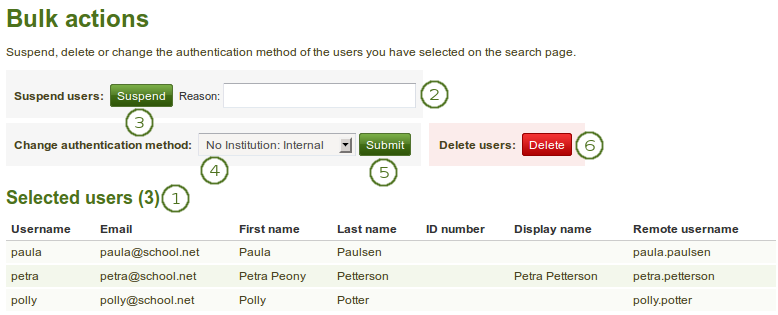
User bulk actions
Once you have selected users for whom you wish to perform the same action on the User search page and clicked the Edit button, you can take any of the following steps.
- Selected users: Review the users you have selected for performing bulk actions.
- Reason: Provide a reason for suspending the users listed on this page. You need to click the Suspend button in order to suspend the users.
- Click the Suspend button to prevent these users from accessing their accounts.
- Change authentication method: Choose a new authentication method from the drop-down menu for the users listed on this page.
- Click the Submit button to change the authentication method to the new one.
- Click the Delete button to delete accounts and all of their content of the users listed on this page.
Waarschuwing
When you delete accounts, all user data will be lost and cannot be recovered unless from a server backup file.
8.3.1.2. User reports¶
You can download basic user information for easier updating of these via a CSV file.
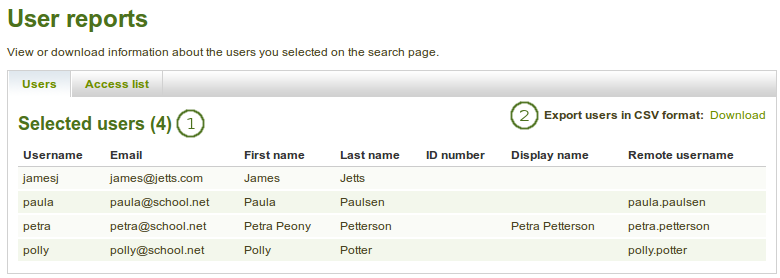
User reports
In order to get to the User reports page, you must select users for whom you wish to perform the same action on the User search page and click on the Get reports button.
- Selected users: You can then review the user information that will be included in the CSV file.
- Export users in CSV format: Click the Download link to download the information that you see on this page as CSV file.
Notitie
You can use this CSV file later on for updating existing accounts.
In addition to downloading basic user information, you can also view all the pages that have been created by the users and with whom they have been shared. This facilitates for example troubleshooting when users cannot view pages of others and the administrator would have to log in to the user account to check page permissions.
Notitie
This list is only available to site and institution administrators unless staff receive access to this list as well. The site administrator can decide that in the User settings in the option “Staff report access”.
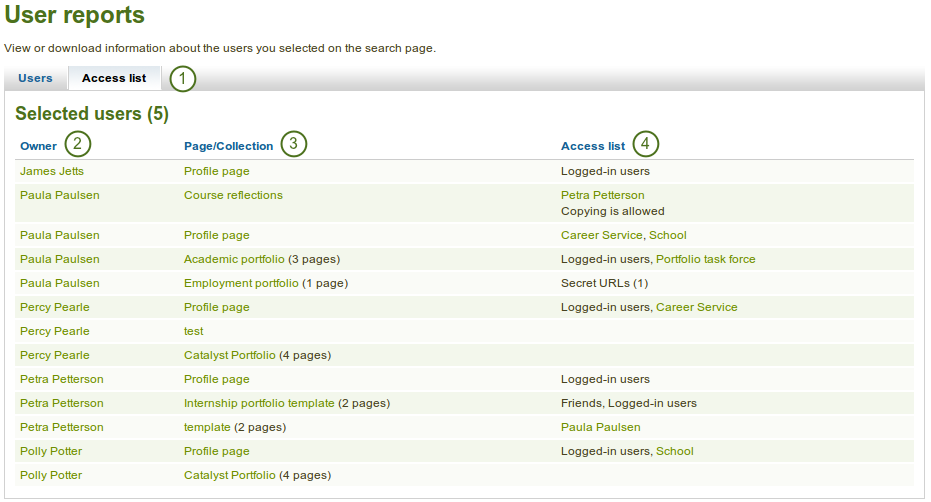
User report page access list
- Click the Access list tab on the User reports page.
- The owners of the pages are listed.
- All the pages that the users have created are listed. If a collection is listed instead, the number of pages it contains is displayed.
- The users or groups of people who have access to any page or collection are displayed.
Notitie
Though all pages, collections and groups are linked, you may not have direct access to them if you are not on the access list or a member of the group yourself.
8.3.2. User account settings¶
Administration → Users → User search → Click on a username
On the Account settings page of a user in the administration area, you can perform a number of actions to manage the user’s account. However, you cannot change personal information about this user, e.g. name or email, from this page. This can only be done in the Content area of the user’s account or via the Add users by CSV page.
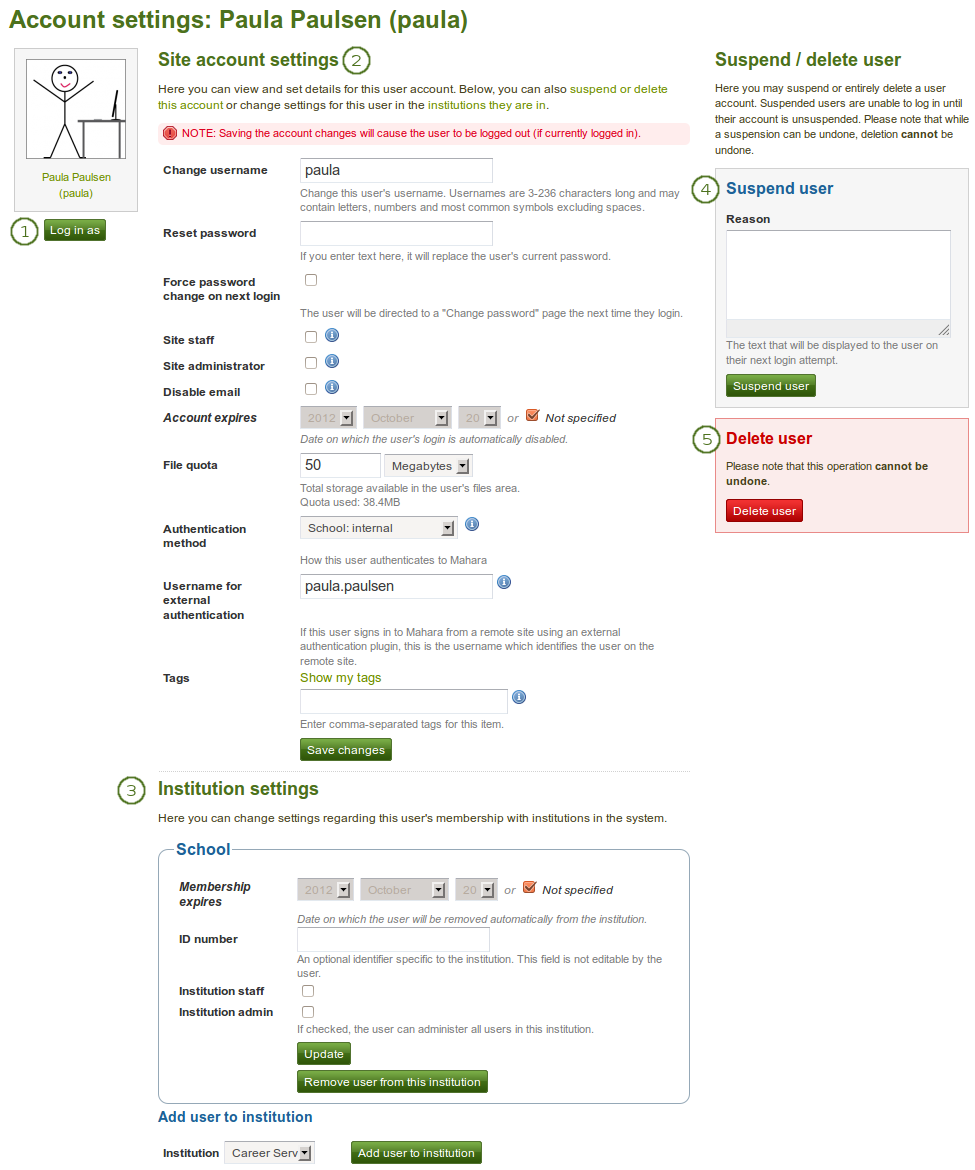
Overview of the user account settings page
- Log in as this user.
- Change site account settings.
- Change institution settings.
- Suspend this user.
- Delete this user.
8.3.2.1. Log in as¶
As administrator you have the power to log in as any user that you manage and masquerade as them.
Notitie
Site administrator can log in as any user while institution administrators can only perform this action for users who are members of their institution(s).
It is a great function for troubleshooting a user account because you see everything as the user would without having to know the password.
Waarschuwing
This function can be misused by administrators because you can make changes to the user’s portfolio and artefacts as well as participate in groups while logged in as that user. Users should be aware of this function and that an administrator can enter their account.
Sites should have clear policies around the use of this function so that the privacy of users and their portfolios and collaborative work is protected. Therefore, there should also not be many users within an institution who have administrator rights.
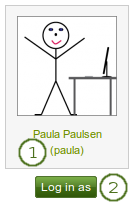
Log in as another user
- Click on the user’s name to go to this user’s profile page. You can then click the Log in as … link to become that user.
- Click the Log in as button to become that user. You see a red bar at the top of the browser window telling you that you are masquerading as that user.

Stop masquerading as another user
When you want to return to your own account again, click the Become [your name] again link at the top of the browser window.
8.3.2.2. Change site account settings¶
You can view and change a number of settings for a user’s account.
Notitie
Depending on the authentication method that is associated with this user, you may not be able to edit all settings.
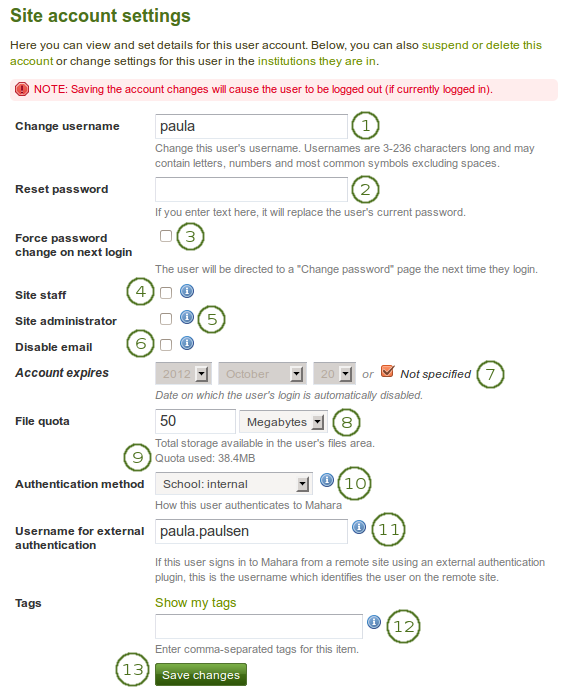
Site account settings of a user
- Change username: Give the user a different username. This field is not available when the account is managed by an external authentication method.
- Reset password: Change the password for this user account. This field is not available when the account is managed by an external authentication method.
- Force password change on next login: Check this box if the user shall change the password upon the next login. This field is not available when the account is managed by an external authentication method.
- Site staff: Check this box if the user shall become a staff member for the entire site.
- Site administrator: Check this box if the user shall have full administrative rights for the entire site.
- Disable email: Check this box to disable the sending of emails for this user. If email is disabled, notifications and messages can only be viewed in the internal inbox.
 You can set up your Mahara site so that emails are disabled automatically if they are bounced back.
You can set up your Mahara site so that emails are disabled automatically if they are bounced back. - Account expires: Choose the date on which the user’s login is automatically disabled. The default setting is that the date is not specified. You always see the current date in the greyed out date fields. You can set an automatic account expiry date for all users in the account settings of the site configuration.
- File quota: Change the storage allowance for a user’s personal files area. Institution administrators may not be able to update the quota if the site administrator disallowed that. The default value as set in the files configuration in the plugin administration.
- Quota used: You can see how much this user has already used of their allocated quota.
- Authentication method: Choose the authentication method for this user. A site administrator can set up the authentication methods in the institution administration. Depending on the authentication method that you have chosen, you may have to provide a remote username to allow the user to log in.
- Username for external authentication: Add or change the remote username for the chosen external authentication method here. Per default, if no external authentication method is chosen, the internal username is displayed.
- Tags: A user can be tagged by an administrator. The tag of the institution to which the user belonged prior to joining a new institution is not displayed to avoid its deletion.
- Click the Save changes button when you are done editing the settings.
Waarschuwing
When the email address is disabled, users cannot reset their passwords themselves as no email can be sent.
8.3.2.3. Change institution settings¶
You can view and change settings regarding a user’s membership in institutions. Depending on the site settings for institutions, a user may be added to more than one institution.
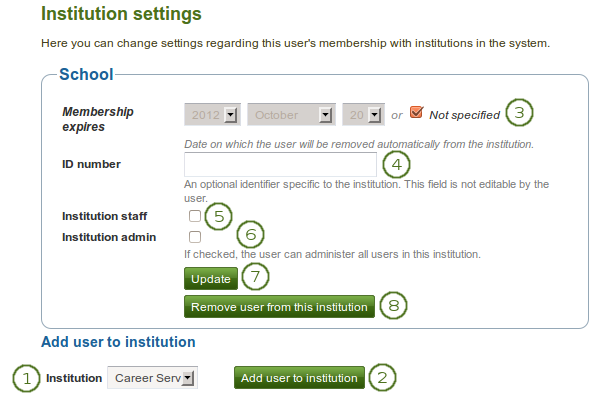
Institution settings for a user
- Institution: Choose the institution to which you want to add this user from the drop-down menu.
- Click the Add user to institution button to make this user a member of this institution.
- Membership expires: If you wish, specify the date when the user will be removed from this institution automatically. If you click the “Not specified” check box, no end date will be set. The date displayed in the greyed out date boxes is always the current one when “Not specified” is chosen.
- ID number: Provide an optional identifier for this user in this institution. This field is not editable by the user.
- Institution staff: Check this box if you want to give this user staff rights in this institution. This will allow them to create controlled groups for example.
- Institution admin: Check this box if you want to make this user an administrator of this institution. This will allow them to manage all users in this institution for example.
- Click the Update button to save your changes.
- Click the Remove user from this institution button to disassociate this user from this institution. The user’s account will not be deleted. The user will only not be associated with this institution anymore.
8.3.2.4. Suspend user¶
Suspend a user if they do not follow the terms and conditions of the site and behave inappropriately. Suspended users cannot log in, but all their content is still available.
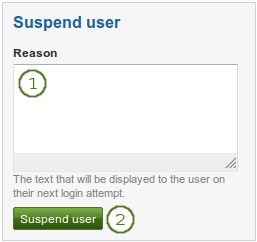
Suspend a user
- Reason: Provide a reason for your suspension. This is particularly useful when you are not the only administrator and / or need to remember after some time why you suspended this user.
- Click the Suspend user button to disallow the user from logging in.

Suspension notice on the user account settings page
When a user has been suspended, the suspension message appears on the user’s account settings page stating the reason and the date for the suspension and giving the administrators the possibility to unsuspend the user by clicking the Unsuspend user button.

Suspended user tries to log in and gets suspension message
When the user tries to log in, they will see the suspension message and the reason. They can then contact an administrator via the “Contact us” form for further action.
8.3.2.5. Delete user¶
Users can delete their own accounts in their account settings if self-registration is allowed to by their institution. Administrators can also delete user accounts at any time.
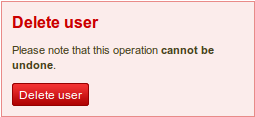
Delete a user account
Click the Delete user button to delete this user account permanently. This action cannot be undone. As this is a permanent action, you see a confirmation pop-up window that you will have to acknowledge.
Waarschuwing
When you delete a user account, all personal data is wiped from the system. This applies to everything that is in a user’s Content and Portfolio area. This action cannot be undone. The user’s contributions in groups, e.g. forum messages, uploaded files and pages created in a group, are still available, but are made anonymous by changing the name to “Deleted user” as author where an author is shown.
Notitie
If an account was deleted by accident - either by a user or by an administrator - swift action may result in recovery of (most of) the data from a backup file. This requires access to the server’s backups and the backend of Mahara. More information is available on the wiki under Restoring a deleted user.
8.3.3. Suspended and expired users¶
Administration → Users → Suspended and expired users
A list of all suspended and expired users is available in the sub-menu Suspended and expired users. Here you can unsuspend / reactivate or delete them.
Notitie
Site administrators see all users whereas institution administrators only see users who are members of their institution(s).

List of all suspended or expired users
- Show: Select whether you wish to see suspended or expired users.
- Select the user(s) for which you want to perform the same action.
- Click the Reactivate expired users button if you want to allow these users access to their accounts again.
- Click the Delete users button to delete all selected users in bulk. This action cannot be undone and all personal information of these users will be deleted (see delete user).
- Click the Unsuspend users button to reinstate the accounts for all selected users.
Waarschuwing
When you delete a user account, all personal data is wiped from the system. This applies to everything that is in a user’s Content and Portfolio area. This action cannot be undone. The user’s contributions in groups, e.g. forum messages, uploaded files and pages created in a group, are still available, but are made anonymous by changing the name to “Deleted user” as author where an author is shown.
8.3.4. Site staff¶
Administration → Users → Site staff
Notitie
Site staff is only accessible by site administrators.
On this page you can choose which users receive site staff rights. Potential staff members - any user on the site - are listed on the left while existing site staff members are listed on the right.
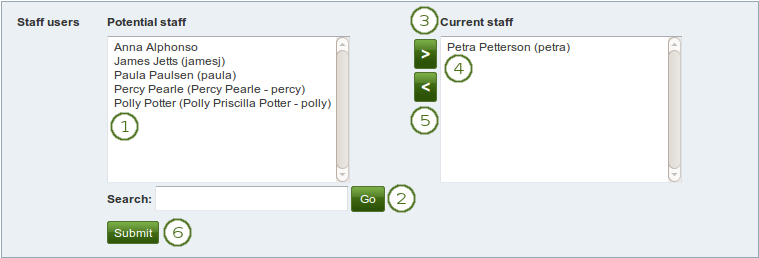
Give site staff rights
- Potential staff: Select the users you wish to make site staff. You can select multiple users at once using
CtrlandShiftclick. - Search: If you have too many users on your site and you cannot see / find the users you want, you can search for them here.
- Add the potential staff members to the right-hand side - Current staff - by clicking the right-arrow button
 .
. - Current staff: If you want to remove an existing or accidentally added site staff member, you can remove the user from the list on the right-hand side by clicking on the user.
- Then click the left-arrow button
 , and the user is removed from the list.
, and the user is removed from the list. - When you have chosen all members you wish to make site staff, click the Submit button.
Notitie
You can also double-click a name and it will be moved to the other side.
8.3.5. Site administrators¶
Administration → Users → Site administrators
Notitie
Site administrators is only accessible by site administrators.
Site administrators have powerful rights. They can make far-reaching changes and also log in as other users. Be careful whom you give these rights. One site administrator is needed for each site. The total number of site administrators should be kept small.
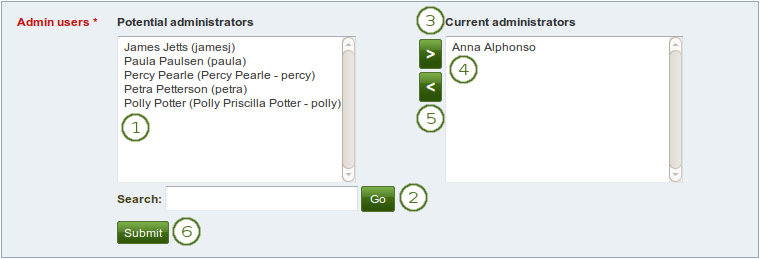
Give site admin rights
- Potential administrators: Select the users you wish to make site administrators. You can select multiple users at once using
CtrlandShiftclick. - Search: If you have too many users on your site and you cannot see / find the users you want, you can search for them here.
- Add the potential site admin to the right-hand side - Current administrators - by clicking the right-arrow button
 .
. - Current administrators: If you want to remove an existing or accidentally added site administrator, you can remove the user from the list on the right-hand side by clicking on the user.
- Then click the left-arrow button
 , and the user is removed from the list.
, and the user is removed from the list. - When you have chosen all members you wish to make site administrators, click the Submit button.
Notitie
You can also double-click a name and it will be moved to the other side.
8.3.6. Add user¶
Administration → Users → Add user
You can add users to your site (site administrator) or your institution (institution administrator) by creating accounts for them manually one by one.
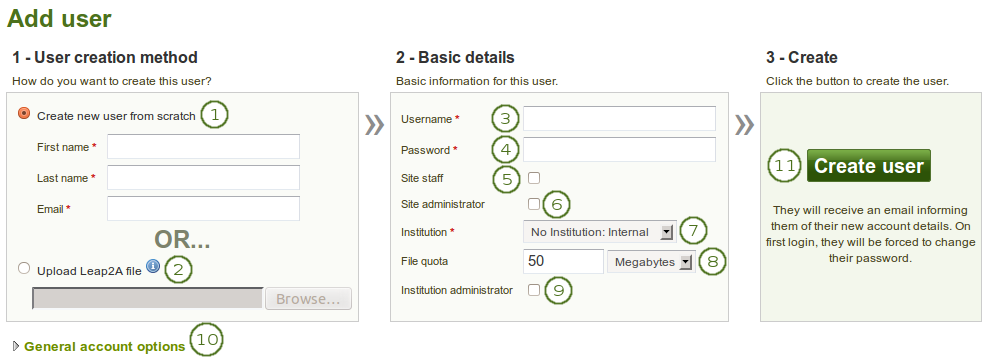
Add a user manually
- Click the Create new user from scratch radio button if you want to create an empty account. Provide the first name, last name and email address for this user.
- Click the Upload Leap2A file radio button if you want to import a user from another Mahara instance or a system that supports the Leap2A standard. Such a user could have exported their portfolio from another Mahara instance.
- Username: Give the new user a username. It may contain letters, numbers and most common symbols. It must be from 3 to 236 characters in length. Spaces are not allowed.
- Password: Choose a password for the account. The password must be at least six characters long.
- Site staff: Check this box if the new user should have site staff rights. Only site administrators see this option.
- Site administrator: Check this box if the new user should have site administrator rights. Only site administrators see this option.
- Institution: Choose the institution of which the user should be a member.
- File quota: Review the allocated file quota. You may change it here for this user if you are allowed to.
- Institution administrator: Check this box if the new user should have institution administrator rights in the chosen institution.
- General account options: Expand this menu to see default account options that you may choose to change while creating this user. These are the general account options a user can change on the Settings page.
- Click the Create user button.
- The user will receive an email with the account details.
Notitie
You can only define the default account settings for a user account, but not force the user to keep them forever. You could only do that by customising the system on the code level.
8.3.7. Add and update users by CSV¶
Administration → Users → Add users by CSV
You can use this function to upload new users in bulk via a CSV file (comma-separated file) and to update existing users. The first row of your CSV file should specify the format of your data. For example, it should look like this:
username,password,email,firstname,lastname,studentid
For new users, this row must include:
- username
- password
- firstname
- lastname
Notitie
If you want to update existing users, you do not need to set a password.
You can mix new and existing accounts in your CSV file.
Your file must also include fields that are mandatory for all users to fill out and any fields locked for the institution you are uploading the users for.
All other fields are optional. This is the full list of additional fields that you can add in your CSV file upload.
- address - Street address
- aimscreenname - AIM screen name
- blogaddress - URL to the blog
- businessnumber - Work phone number
- city - City
- country - Country
- faxnumber - Fax number
- homenumber - Home phone number
- industry - Industry is displayed in the profile
- introduction - Introduction is displayed in the profile
- icqnumber - ICQ nickname
- jabberusername - Jabber ID
- maildisabled - Selection to disable the email address
- mobilenumber - Mobile phone number
- msnnumber - MSN nickname
- occupation - Occupation is displayed in the profile
- officialwebsite - Official web site
- personalwebsite - Personal web site
- preferredname - Display name
- remoteuser - Remote username for external authentication
- skypeusername - Skype ID
- studentid - Student ID is displayed in the profile
- town - Town
- yahoochat - Yahoo Chat username
Your CSV file could look for example like the following:
username,email,firstname,lastname,studentid,preferredname,remoteuser, password"percy","percy@pearle.net","Percy","Pearle","","","percy.pearle","mahara1""petra","petra@petterson.net","Petra","Petterson","","","petra.petterson","mahara1""polly","polly@potter.net","Polly","Potter","","","polly.potter","mahara1""admin","admin@mahara.school","Admin","User","","","","mahara1""jamesj","james@jetts.com","James","Jetts","","","","mahara1"When you have created your CSV file, you are ready to upload it.
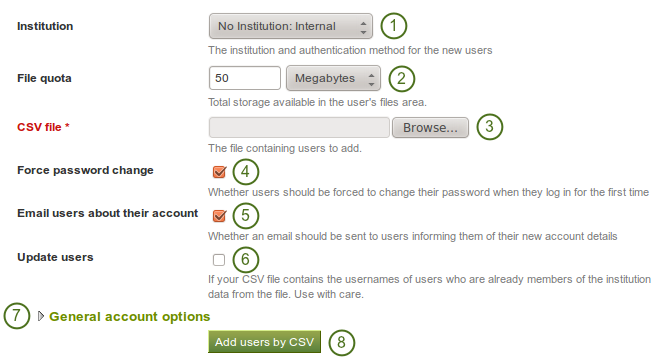
Add users by CSV file
- Institution: Choose the institution and the authentication method for the user accounts that you upload and / or change.
- File quota: If you wish, you can set a different file quota for all accounts in the CSV file. Institution administrators can only do so if the site administrator allowed it.
- CVS file: You must upload a CSV file by clicking the Browse button and then selecting it from the files area on your computer.
- Force password change: If you select this option, users need to change their password before they can log in for the first time.
- Email users about their account: If you select this option, users will receive an email with their account information. This is in particular good for internal accounts. For user accounts that are managed for example by Moodle or through LDAP, you do not have to select this option because the users should already know their login information.
- Update users: Select this option if your CSV file contains changes for existing users.
- General account options: Expand this menu to see default account options that you may choose to change while creating or updating users. These are the general account options a user can change on the Settings page.
- Click the Add users by CSV button to upload and / or change users.
Notitie
Depending on your server settings and / or the size of your installation, you may not be able to upload all user accounts at once. You may wish to upload them in bunches of 100 instead.
8.3.8. Change the authentication method and remote username in bulk¶
After you have successfully invited or added new members into your institution, you can change their authentication method. That can be useful if the authentication method differs from the one in the previous institution and you want to link the new accounts to a remote username using:
- LDAP directory
- Moodle accounts via MNet
- Single sign-on through an IdP provider
Notitie
The change in the authentication method for existing accounts should be done before users try to log in with their new credentials to avoid the creation of a second account for these users.
You can change the authentication method for multiple users at once to save you time manually updating each user. Changing the authentication method usually also entails changing the remote username (a.k.a. username for external authentication). Therefore, these two are dealt with together to describe the work flow better.
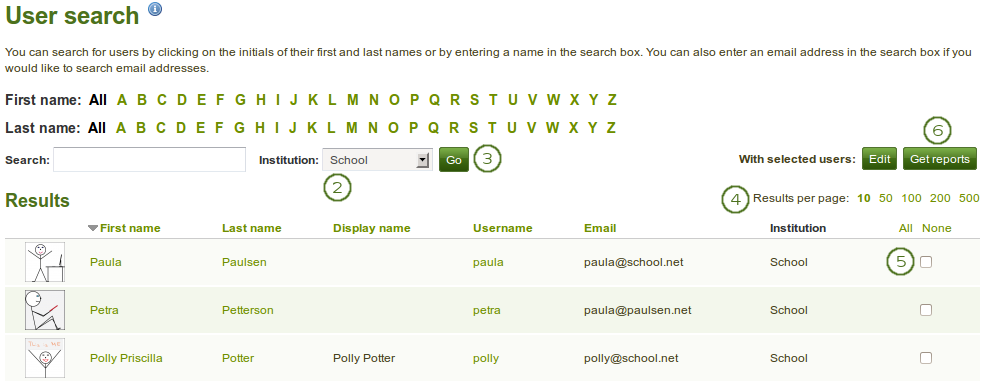
Find users in an institution to change their remote username
- Go to Administration → Users → User search.
- From the drop-down menu choose the institution in which the members are whose authentication method and remote username you want to change / add.
- Click the Go button to limit your results to these institution members.
- Change the Results per page if you wish to see more than 10 users per page.
- Select the users whose authentication method and remote username you want to change by either putting a check mark in the check boxes or clicking on All to select all users on that page.
- Click the Get reports button to proceed to the next step. You are taken to the User reports page.

User reports page

Update the CSV file with remote username and password
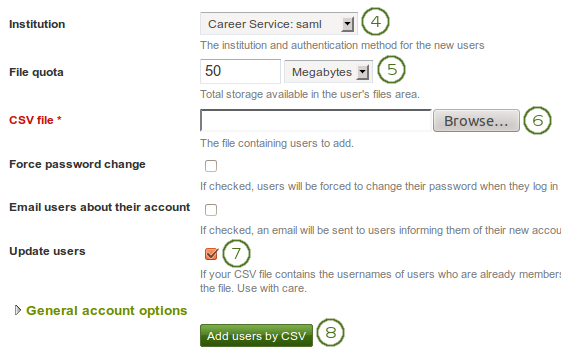
Update user accounts in bulk
- Export users in CSV format: Click the Download link so that you get a CSV file which contains all necessary information for you to change the users’ remote username in bulk. This is necessary if their internal Mahara username is not the same as the one they use to authenticate on your system that is linked to Mahara or if they already have a remote username that would be incorrect for your institution.
- Open the CSV file in your preferred spreadsheet software. In the column remoteuser, add or change the username that your users have when authenticating in your regular system that you have connected to Mahara. You may also change other fields, e.g. their name, email address etc. If you want to add a new user directly in this CSV file, you can do so as well.
- Go to Administration → Users → Add users by CSV.
- Institution: Choose the correct institution and authentication method for which you want to update your users. This allows you to switch all users in the CSV file from one authentication method to another.
- CSV file: Choose the CSV file from your computer that you had updated.
- Update users: Put a check mark here because you want to update existing user accounts.
- General account options: You can make changes to the default account options for all the users, e.g. give them multiple journals by default, change their interface language etc.
- Click the Add users by CSV button to start the user update. This process may take a little while depending on how many users you are changing.
- You receive a report on the page upon the successful completion of the upgrade. If the upgrade fails, error messages help you to resolve the problem. No users are updated until all errors are resolved.
Notitie
If you intend to update more than 100 users at the same time, you may run into problems, and the server may reject your CSV file as the update process is a very memory intense one. If that is the case, you would have to split your CSV file into smaller ones with fewer users in them.
You can check that the accounts had their remote usernames added:
- Go to Administration → Users → User search.
- Select the institution in which the members are whom you want to check.
- Click the Go button to limit your user results to this institution.
- Select the users for whom you want to check the remote usernames.
- Click the Get reports button to proceed to the next step. You are taken to the User reports page.
- You see the remote username in the last column.
Zie ook
If you only want to change the authentication method of certain users but do not have to worry about a remote username or updating any other information, you can change the authentication method directly on the bulk actions screen.